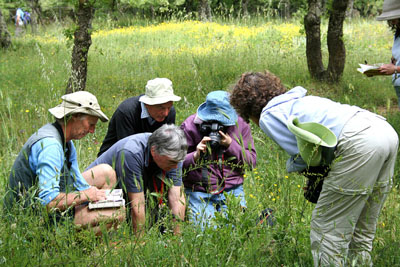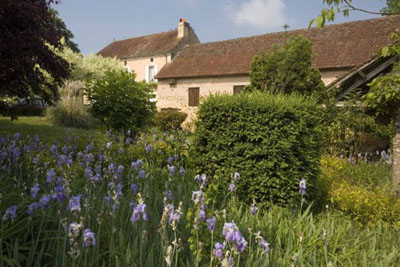![]()
FRANCE
THE DORDOGNE & THE CÉVENNES
A NATURAL HISTORY TOUR OFFERED BY THE NEW YORK BOTANICAL GARDEN
MAY 18 – 25, 2008
NYBG LEADERS: Scott Mori & Carol Gracie; GUIDES: Bob Gibbons
![]()
The Dordogne region, where flowery limestone grasslands are set amidst old woodland in a land dissected by beautiful gorges is one of the loveliest parts of France.
 |
Botanizing in a European meadow © Carol Gracie |
We will meet at the airport in Toulouse at 4:00 pm on May 16th and transfer to the beautiful Castang, a lovely old converted farm near Sarlat-la-Canéda. The area around the house is delightfully unspoiled with masses of green-winged orchids on the lawn (and many other orchids nearby), birds such as hoopoes, wrynecks, and red-backed shrikes breeding locally, and a wealth of butterflies. The food and general ambience are superb, with all meals provided, including a 5-course dinner with wine, in a charming atmosphere. A swimming pool near the house may be ready for use depending on the weather.
During our stay at Castang, the tour will consist of a mixture of local walks and short trips further afield to gorges, woodlands, limestone pastures, and fens. We may visit a local market, one of the internationally famous caves, or take a boat trip along the Dordogne below the cliffs. The flora is very rich, and we will soon become blasé about such amazing plants as lizard orchids, which occur in some abundance. On a previous trip, 35 species of orchids were recorded in one week. It is a fine area for birds, and we should see or hear various birds of prey including the short-toed eagle, hobby, and honey buzzard, a range of warblers; scops and barn owls; crag martins, alpine swifts, and an abundance of nightingales. Although we will be a little early for the peak of butterfly season, we can still expect to see 30 or more species, including several fritillaries, Adonis blues, and purple-edged and large coppers. Bats can be seen around the buildings on warm evenings, and midwife toads and mole crickets can be heard, and the glow-worms may have started glowing.
 |
Our lodging during our stay in Dordogne © Bob Gibbons |
On day 6, we will transfer a few hours to the east into the lovely Cévennes. Our hotel is beautifully situated in a small village where two major gorges meet. From here we can walk straight out into the surrounding gorges and hills and travel further afield onto the high causses (limestone plateaus) and mountain areas in the Cévennes National Park. We are only a mile from a large griffon vulture breeding colony, and we should get good views of the birds. The Cévennes has a wonderful flora and fauna. There are orchids in abundance, including endemic specialties. We should also see at least two species of native daffodils, globularias, pasque flowers, and many other species. Plan your departure from Toulouse after 5:00 pm on May 25th or later.
Our guide will be Dr. Bob Gibbons. Bob is the author and/or photographer of over 30 books, among them Travellers’ Nature Guides: Greece and Flowers at My Feet. His patience, enthusiasm, and knowledge of flora and fauna will add much to the pleasure of the trip. If registration warrants, an additional guide will join us.
Dr. Scott Mori and his wife, Carol Gracie, have extensive research and guiding experience and have led over 35 tours for The New York Botanical Garden. They are authors of A Guide to the Vascular Plants of Central French Guiana, among other publications. Carol’s book, Wildflowers in the Field and Forest: the Northeastern United States was published in April of 2006.
Tour Fee: $3295 (based on 10 participants), not including airfare. Request a registration form and send it with a $400 per person non-refundable deposit payable to The New York Botanical Garden to: Carol Gracie, The New York Botanical Garden, Bronx, NY 10458. For additional information, e-mail cgracie@nybg.org (best method of contact) or call 718-817-8647.
Go to More Information
Go to Reservation Form
Go back to Ecotours